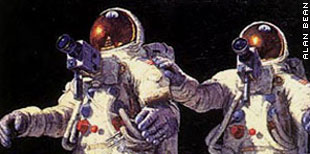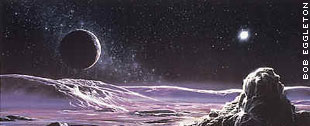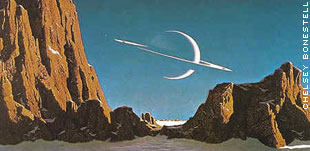The First Ones There
by Kim Poor
It's a "given" that collectSPACE readers are space junkies. Most collectors of space memorabilia are not one-dimensional, and have another interest, adjunct to their hobby that compliments it. Some may own telescopes or binoculars for the purpose of gazing in wonder at the cosmos (or neighbors on cloudy nights!). Certainly if this is so, you have studied a distant planet or nebula and wondered what it must be like to be there.

Such are the dreams of a small group of specialized artists who have chosen space as their subject matter. Often fanatical observers themselves, though frustrated at the limits of what can be seen by mere lenses and mirrors, they are stuck on Earth while their minds roam the stars. I am one of those.
With the singular exception of artist Alan Bean, who has actually seen an alien world firsthand, the rest of us are earthbound pretenders. However, through scientific examination and deduction, discussions and interviews with experts, and a healthy dose of artistic interpretation, style and license, we are able to render a plausible scene which is compelling, colorful and accurate enough to be used in magazines, encyclopediae, and as reference material to illustrate some otherwise obtuse concept or a truly alien landscape. Thus a space art piece can be uniquely an illustration as well as fine art; educational as well as emotionally fulfilling. The major criterion for a good space art painting is "It makes you want to go there".

When I met astronaut/artist Alan Bean at a shopping mall art show in Houston fifteen years ago, I felt embarassed when he closely examined my paintings. "It must seem ludicrous to you that I presume to know what it's like in outer space," I said. "Absolutely not," he replied. "I've seen only one nearby corner of the Universe. You capture the feeling of deep space, and your subjects are not confined to our Solar System."
Most space artists know each other. We are a small, close-knit group. Even before we had an official, incorporated art guild, website (http://iaaa.org/), or a listserv, we gathered at several painting workshops held in exotic, planetary locales, (Hawaii, Death Valley, Iceland, etc.) with lectures by local astronomers and geologists. (Indeed, some of our artists, such as Dr. William K. Hartmann and Dr. Dan Durda are they themselves well-published and noted planetary scientists). We'd travel to sights and destinations, sketch and photograph scenes during the day, quickly digest them, and paint (and party) furiously all night.
This is not to say all space art looks the same. Quite the contrary. Although we freely exchange information, the variety of expression echoes that of the Universe itself. Even when presented with the same visual and verbal reference, the sheer variety of the artists' output is astounding.

Our comraderie contributes to the advancement of the space art genre. Space art is a true "school" in every sense of the word, exchanging not only friendship and technique, but also knowledge and expertise in a highly technical and scientific subject. Parallels can be drawn in the art of medical illustration, paleo (dinosaur) art, and even wildlife and western art. The trend these days is to become an expert in your field of art. Ask any space artist to explain their work, and you are likely to get a Sagan-esque response, replete with both hard science and personal theories.
Space artists must be well-versed in a myriad of sciences: not only the obvious astronomy, astrophysics and cosmology, but also geology, atmospheric physics, and depending on their favorite flavor of space art, biology and anthropolgy for alien lifeforms, engineering for any "hardware" (spacecraft, structures, etc.), or theoretical physics if you paint black holes, neutron stars, or the big bang. Most of us maintain a "cabinet" of favorite and well-known scientists as advisors, bribing them with art in exchange for precious nuggets of information.
Collecting space art
As with anything else, space art collections start with any entry level, committment and direction. You can pick a favorite artist, favorite subject, or even a color scheme to match your couch! (Although most artists abhor being used to match decor). You can choose original art, prints, books or any combination to start your collection. Art, like memoribilia and autographs, often appreciates in value over time, but this is the icing, and not the cake. Space art has the ability to take you on a journey to a personal place, an alien vista all your own, anytime you want. Such is the power of art.
Where to start
The Internet is the best place to see a variety of space art. The IAAA members site contains links to many artists' personal sites. Most of the world's space artists are members of the group. Some aren't, but a search on their name will usually turn up something.
A shameless plug
Of course my gallery is also a good source, though we don't have every space artist, we have a good selection by a couple dozen of the best. We carry works in all price ranges, from screen savers to original art, and everything in between. Novaspace Galleries began as Kim Poor Space Art in 1978, and became Novagraphics a few years later when I added some esteemed colleagues to the lineup. When all four numbers on the calendar changed, we became Novaspace Galleries to more closely match our domain name. We are the only gallery devoted to space art, and also the largest dealer for the art of old friend Alan Bean. Through our liason with him, and his recommendations of us to his colleagues, we have also become a leader in the field of astronaut autographed art and photos.
We saw the potential of the World Wide Web soon after its inception, and now have one of the oldest and largest (1250+ pages) sites on the web. We've also been told it is one of the most beautiful -- not because of clever design or java-based wizardry, but merely for the hundreds of dazzling space art jewels it contains by the world's best.
 Up Next: Masters of Space Art
|




